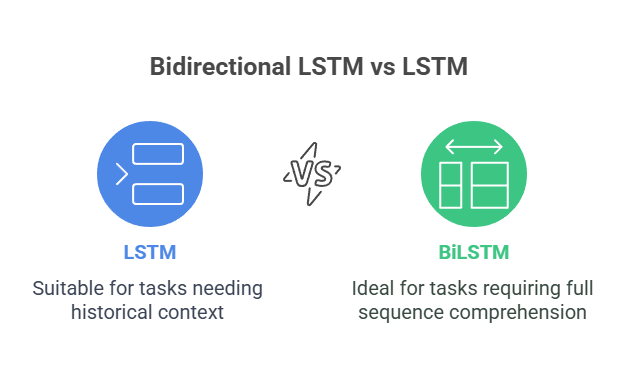This article gives an Overview of Bidirectional LSTM vs LSTM , What is BiLSTM, Architecture, advantages and so on.
One kind of recurrent neural network (RNN) architecture that expands on the conventional Long Short-Term Memory (LSTM) model is called a Bidirectional LSTM (BiLSTM). The hidden state at a particular time step only contains information about the previous inputs up to that point since standard (unidirectional) RNNs analyze sequence inputs in a single direction, usually from left to right. When the future context is likewise pertinent to a choice or representation at the current time step, this restricts their capacity to completely capture context.
BiLSTM Architecture
Utilizing information from both the prior (left) and succeeding (right) contexts within a sequence is the fundamental concept of a BiLSTM. Two separate RNNs (usually LSTMs in contemporary implementations) working in tandem make up a BiLSTM in order to do this:
- The input sequence is processed from start to finish (e.g., left-to-right) by a forward RNN.
- In a backward RNN, the input sequence is processed from the end to the beginning (for example, from right to left).
The identical vector representation of the current token (xt) is used as input for both the forward and backward RNNs. The hidden states for the forward pass and the backward pass are h(f)t and h(b)t, respectively. At first, the interaction between these forward and backward concealed states is limited to their respective orientations.
The associated hidden states from the forward and backward passes are then combined to provide the output representation for a token at a certain location (let’s say, i) in the sequence. Concatenation is usually used to accomplish this combination. Both the left and the right sides of the current token’s context are successfully captured by the combined vector ht = [h(f)t ; h(b)t] or ht = h(f)t ⊕ h(b)t. Together, the forward and backward networks’ parameters are learnt.
Advantages of Bidirectional Architectures with LSTMs
Although basic RNNs can incorporate the idea of bidirectional processing, LSTMs are the common unit in contemporary recurrent networks. As was previously said, LSTMs are specifically built with a cell state and gating mechanisms (forget, input, and output gates) to better control information flow over lengthy sequences and solve the vanishing gradient issue that basic RNNs have trouble with. The forward and backward passes both gain from the LSTM’s capacity to gather and store pertinent data over perhaps lengthy time steps, both forward and backward through the sequence, when LSTM units are installed in the bidirectional framework. The term “biLSTM” is commonly used to describe a bidirectional LSTM.
Benefits
Improved Context Understanding: BiLSTMs can gain a more thorough understanding of the context of each element in the sequence by combining data from both directions. This is especially helpful for jobs where choices made at one stage of the sequence rely on later-appearing items.
Enhanced Performance: Complex RNN designs, such as bidirectional ones, have been shown empirically to outperform simpler RNNs on more difficult NLP tasks. They have a reputation for delivering excellent outcomes.
Better Sequence Representation: In contrast to the final state of a unidirectional RNN, which may be biassed towards the conclusion of the sequence, the output vector at each step in a BiLSTM offers a rich, contextualized representation of that element based on the whole sequence.
Applications
In NLP and other fields, BiLSTMs are ideal for a variety of sequential processing tasks, especially those in which bidirectional context enhances predictions or representations:
Sequence Labeling/Tagging: Giving each component of a series a label, like:
- POS (Part-of-Speech) Tagging
- Identifying each word’s grammatical category.
- Named Entity Recognition (NER): Recognizing and categorizing identified items in text, such as people, places, or organizations.
- Labelling Semantic Roles.
- Supertagging of CCG.
Sequence Classification: Giving a whole sequence a single label, like:
- Examination of sentiment.
- Categorization of topics.
- Categorization of sequence pairs (e.g., paraphrase detection, entailment).
Sequence-to-Sequence Models: Encoder-decoder architectures are utilised for activities like
- Machine translation. A BiLSTM is frequently used in the encoder portion to produce a thorough representation of the source sequence.
Additional Sequence Processing Assignments:
- Recognition of handwriting.
- Speech recognition.
- Syntactic parsing.
- When discussing coreference resolution, bring up embedding.
- Parsing discourse (e.g., with hierarchical BiLSTMs).
- Prediction of secondary structures in proteins.
Variants and Related Concepts
- Stacked/Deep BiLSTMs: To build deeper networks and maybe learn more intricate hierarchical representations, several BiLSTM layers can be stacked on top of one another.
- BiLSTM-CRF: A popular sequence labelling architecture that models relationships between neighbouring labels using a Conditional Random Field (CRF) layer and a BiLSTM for feature extraction.
- Bidirectional GRUs: Bidirectional architectures can also make use of Gated Recurrent Units (GRUs), which are less complicated substitutes for LSTMs.
Bidirectional LSTMs are a potent extension of the standard LSTM that, by processing sequences both forward and backward, greatly improve the network’s capacity to capture context. This results in better performance on a variety of NLP tasks that call for in-depth sequential understanding.
Bidirectional LSTM vs LSTM

| Feature | LSTM | BiLSTM |
|---|---|---|
| Directionality | One-way processing (forward or backward) | Two-way processing (both forward and backward) |
| Contextual Data | Uses only historical context to forecast the future | Uses both past and future context for prediction |
| Intricacy | Less complex in architecture and computation | More complex; dual sequence processing increases computational demand |
| Performance | Sufficient for tasks relying only on historical data | Typically delivers better results when full context is necessary |
| Applications | Speech recognition, time series prediction | Named entity recognition, sentiment analysis, machine translation |
| Memory Needs | Lower memory usage | Higher memory usage due to dual path processing |
| Training Time | Faster due to single-direction processing | Slower because it processes in both directions simultaneously |
